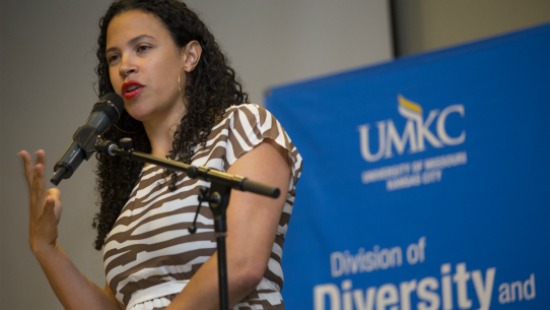DePaul among first to offer critical ethnic studies graduate programPosted in Articles, Campus Life, Media Archive, Social Science, United States on 2018-06-07 15:17Z by Steven |
DePaul among first to offer critical ethnic studies graduate program
DePaul University Newsline
Chicago, Illinois
2018-05-31
Nicole Ross, Executive Communications Assistant
 Laura Kina, Vincent DePaul professor in the College of Liberal Arts and Social Sciences, left, and Alexis Beamon, graduate assistant. Kina is the director of the Critical Ethnic Studies MA program and is a visual artist whose research and teaching focuses on Asian American and mixed race history and representation. (DePaul University/Jeff Carrion) |
At this year’s TEDxDePaulUniversity, Whitney Spencer encouraged the audience to question societal norms with her talk, Reimagining the Intellectual. A first-year graduate student in DePaul’s Critical Ethnic Studies program, Spencer highlighted that America’s understanding of what it means to be “an intellectual” is limited by preconceived racial stereotypes.
“As a first-generation college graduate, I aim to critique the construction of black intellectual ‘lack,’ disrupt restrictive ideologies and encourage the intellectual practices of black people,” Spencer says. “I’m continuing to explore this work as a CES graduate student at DePaul.”
DePaul University’s College of Liberal Arts and Social Sciences is among the first in the nation to offer a Master of Arts in Critical Ethnic Studies, which supports the study of such topics by providing an advanced analysis of race and ethnicity. Founded in 2015, the program’s second cohort will graduate this June.
With Chicago as a classroom, students like Spencer examine the systematic marginalization of racial minorities within an urban context as well as the global implications of these structures. This includes a look at how groups use art, culture, political organization and other forms of social expression to respond and counter these forces.
“The program is interdisciplinary and intersectional – pulling from existing courses like women’s and gender and international studies,” says Laura Kina, professor of art, media and design and director of the Critical Ethnic Studies program. “This allows us to look at subjects in a comparative framework.”
Kina first noticed DePaul’s need and opportunity for such a master’s program several years ago. “I helped found the Critical Mixed Race Studies conference at DePaul in 2010, which garnered a lot of attention from the community – so much so that it eventually expanded into its own association,” Kina says. “Around 2011, other faculty members and I started crafting the master’s program to build upon our existing African America and black Diaspora and Latin American and Latino studies programs.”…
Read the entire article here.






